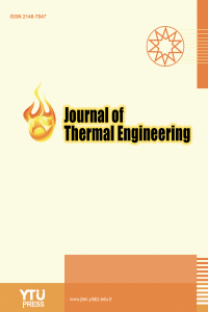Single-phase and two-phase models of a hybrid nanofluid traveling through a non-uniformly heated (PTC) receiver: A comparative study
Single-phase and two-phase models of a hybrid nanofluid traveling through a non-uniformly heated (PTC) receiver: A comparative study
CFD, Forced Convection Parabolic Trough Solar Collector, Hybrid Nanofluid, Two-Phase Modeling, Turbulent Flow,
___
- REFERENCES
- [1] Bejan A, Kraus AD. Heat transfer handbook. Hoboken, NJ: John Wiley, Sons Inc; 2003.
- [2] Choi SUS. Nanofluid technology: current status and future research. Vienna, VA United States: Korea-U.S. Technical Conference on Strategic Technologies; 1998.
- [3] Hussein AK. Applications of nanotechnology in renewable energies-A comprehensive overview and understanding. Renew Sust Energ Rev 2015;42:460–76.
- [4] Hussein AK, Walunj AA, Kolsi L. Applications of nanotechnology to enhance the performance of the direct absorption solar collectors. J Therm Eng 2016;2:529–40.
- [5] Li D, Li Z, Zheng Y, Liu C, Hussein AK, Liu X. Thermal performance of a PCM-filled double-glazing unit with different thermophysical parameters of PCM. Sol Energy 2016;133:207–20.
- [6] Hussein AK. Applications of nanotechnology to improve the performance of solar collectors–Recent advances and overview. Renew Sust Energ Rev 2016;62:767–92.
- [7] Hussein AK, Li D, Kolsi L, Kata S, Sahoo B. A review of nanofluidrole to improve the performance of the heat pipe solar collectors. Energy Procedia 2017;109:417–24.
- [8] Sokhansefat T, Kasaeian AB, Kowsary F. Heat transfer enhancement in parabolic trough collector tube using Al2O3/ synthetic oil nanofluid. Ren Sust Energ Rev 2014;33:636– 44.
- [9] Risi A, Milanese M, Laforgia D. Modelling and optimization of transparent parabolic trough collector based on gas-phase nanofluids. Ren Energ 2013;58:134–9.
- [10] Moghari RM, Akbarinia A, Shariat M, Talebi F, Laur R. Two-phase mixed convection Al2O3 /water nanofluid flow in an annulus. Int J Multipath Flow 2011;37:585–95.
- [11] Sarkar J, Ghosh P, Adil A. A review on hybrid nanofluids: recent research, development, and applications. Renew Sust Energ Rev 2015;43:164–77.
- [12] Madhesh D, Parameshwaran R, Kalaiselvam S. Experimental investigation on convective heat transfer and rheological characteristics of Cu-TiO2 hybrid nanofluids. Exp Therm Fluid Sci 2014;52:104–15.
- [13] Otanicar TP, Phelan PE, Prasher RS, Rosengarten G, Taylor RA. Nanofluid-based direct absorption solar collector. J Renew Sust Energ 2010;2:033102.
- [14] Benabderrahmane A, Aminallah M, Laouedj S, Benazza A, Solano JP. Heat transfer enhancement in a parabolic trough solar receiver using longitudinal fins and nanofluids. J Therm Sci 2016;25:410–7.
- [15] Mwesigye A, Meyer JP. Optimal thermal and thermodynamic performance of a solar parabolic trough receiver with different nanofluids and at different concentration ratios. Appl Energy 2017;193:393–413.
- [16] Coccia G, Di Nicola G, Colla L, Fedele L, Scattolini M. Adoption of nanofluids in low-enthalpy parabolic trough solar collectors: numerical simulation of the yearly yield. Energy Convers Manag 2016;118:306–19.
- [17] Rehan MA, Ali M, Sheikh NA, Khalil MS, Chaudhary GQ, Rashid T, et al. Experimental performance analysis of low concentration ratio solar parabolic trough collectors with nanofluids in winter conditions. Renew Energy 2018;118:742–51.
- [18] Bellos E, Tzivanidis C. Thermal analysis of parabolic trough collector operating with mono and hybrid nanofluids. Sustain Energy Technol Assess 2018;26:105–15.
- [19] Benabderrahmane A, Benazza S, Laouedj S, Solano J. Numerical analysis of compound heat transfer enhancement by single and two-phase models in parabolic trough solar receiver. Mechanika 2017;23:55–61.
- [20] Pandey DK, Lee RB, Paden J. Effects of atmospheric emissivity on clear sky temperatures. Atmos Environ 1994;29:2201–4.
- [21] García-Valladares O, Velázquez N. Numerical simulation of parabolic trough solar collector: improvement using counter flow concentric circular heat exchangers. Int J Heat Mass Transf 2009;52:597–609.
- [22] Mullick SC, Nanda SK. An improved technique for computing the heat loss factor of a tubular absorber. Sol Energy 1989;42:1–7.
- [23] Gnielinski V. New equations for heat and mass transfer in turbulent pipe and channel flow. Int J Chem Eng 1976;16:359–68.
- [24] Petukhov BS. Heat transfer and friction in turbulent pipe flow with variable physical properties. Adv Heat Transf 1970;6:503–64.
- [25] Mills AF. Basic heat mass transfer. 2nd ed. New Jersey: Prentice-Hall; 1999.
- [26] Incropera FP, Dewitt DP. Fundamentals of heat and mass transfer. 3rd ed. New York: John Wiley and Sons; 1990.
- [27] Xuan Y, Li Q. Investigation on convective heat transfer and flow features of nanofluids. J Heat Transf 2003;125:151–5.
- [28] Vasu V, Rama KK, Chandra AKS. Empirical correlations to predict thermophysical and heat transfer characteristics of nanofluids." Therm Sci 2008;12:27–37.
- [29] Duangthongsuk W, Wongwises S. An experimental study on the heat transfer performance and pressure drop of TiO2–water nanofluids flowing under a turbulent flow regime. Int J Heat Mass Transf 2010;53:334–44.
- Yayın Aralığı: 6
- Başlangıç: 2015
- Yayıncı: YILDIZ TEKNİK ÜNİVERSİTESİ
Experimental study on a novel waterless solar collector
Asaad H. SAYER, Wed AL-GRAITI, Hameed B. MAHOOD, Hameed B. MAHOOD, Alasdair N. CAMPBELL
Madan BASNET, D. SENTHILKUMAR, R. YUVARAJ
Shankar DURGAM, Ajinkya BHOSALE, Vivek BHOSALE
Ahmed ALAMI, Lala RAJAOARISOA, Mohammed-hichem BENZAAMA, Abdeldjalil BENBAKHTI
Heat transfer enhancement of electronic devices by using flexible printed circuit boards
Mustafa EMAD, Sattar ALJABAIR, Ahmed Abdulnabi IMRAN
Aram Soleimani VARKANEH, Ghanbar Ali SHEIKHZADEH NOOSHABADI, Ali Akbar Abbasian ARANİ
Manish Kumar CHAUHAN, Akhilesh Kumar CHAUHAN, Yunis KHAN, Abhendra Pratap SINGH
Analysis of thermophysical properties of novel hybrid nanoparticles based vegetable nanofluid
Amol J. ASALEKAR, D.v. A. RAMA SASTRY, M.b.s. Sreekara REDDY, Surendra D. BAREWAR
Experimental analysis of heat transfer characteristics using ultrasonic acoustic waves
Ali Bousri HAMADOUCHE, Nebbali RICHARD
Experimental study on heat transfer from rectangular fins in combined convection
Mehdi BASIRI, Hamid Reza GOSHAYESHI, Issa CHAER, Hadi POURPASHA, Saeed Zeinali HERIS
